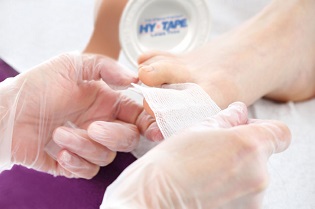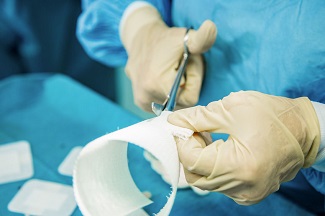Skin Tear Prevention: What Health Care Professionals Need to Know
November 9, 2017
By Hy-Tape International
Skin tears are a major and growing problem for health care professionals, particularly those caring for older patients. By 2060, the population of Americans age 65 or older is projected to grow from approximately 46 million to 98 million and account for 24% of the total population.1 This makes skin tears an issue of increasing concern, and it is important for those caring for older adults to take steps to prevent the problem.
Identifying Risk Factors for Skin Tears
About 1.5 million skin tears occur in the care of older adults every year2. To reduce the incidence of these wounds effectively, it important for health care professionals to understand who is at risk and how skin tears occur. Common risk factors include:
Age - We have already discussed that skin tears are more prevalent in patients of advanced age. However, it is also important to understand why. The turnover of keratinocytes is reduced by 50%, and the dermal-epidermal junction flattens in the later stages of life. These changes, along with an increased risk for other conditions that may result in skin tears, lead to the disparity in cases between the old and the young.2,3
Dry skin - Dry skin is significantly more likely to tear than well-moisturized skin. This occurs because dryness damages the skin barrier and weakens its underlying integrity.2 Older patients are also significantly more likely to have severely dry skin because there is generally reduced activity of the sebaceous and sweat glands with age.2,3
Bruised or damaged skin - Other factors can impair the skin barrier and lead to tissue trauma. Forty percent of all skin tears are associated with skin bruising.2 Excessive exposure to sun, burns, and other conditions can also reduce the effectiveness of skin’s ability to resist tearing.2
Moisture exposure - Incontinent patients or those who are otherwise exposed to excessive moisture may also be more prone to skin tears. Moisture-associated skin damage (MASD), such as incontinence-associated skin damage can both weaken the skin, thus allowing it to become damaged more easily.4
Poor nutrition and hydration - Other, often overlooked, risk factors for skin tears are poor nutrition and inadequate hydration. Without the proper nutrients, the skin can become significantly weaker. If malnutrition is suspected, it is important to consult a nutritionist to help prevent skin tears and other complications.3
Focus on Prevention
By implementing a prevention-oriented approach to skin care, health care practitioners can help patients avoid the cost, pain, and other complications associated with skin tearing. Some best practices include:
Educate nurses and other practitioners - Many in-hospital skin tears occur during care received from staff. By educating nurses and other health care professionals about risk factors and the danger associated with skin tearing, it may be possible to reduce its incidence. Proper skin care should also be taught to patients and other family members to ensure that skin tearing does not occur in the home.2,3
Implement a skin care regimen - A skin care regimen can improve the strength of skin and help reduce the effect of risk factors. Moisturization, keeping the skin free from excess moisture, and using a skin barrier product can all help reduce the risk of skin tears.2,3
Practice proper adhesive removal - The removal of medical adhesives is a common source of skin tears in health care facilities. It is important to remove tape carefully and slowly. Avoid the use of adhesive solvents because these may dry the skin. It is also important to use a medical adhesive that is gentle on the skin and reduces the risk of tearing.2,3
References
1. Mather M. Fact Sheet: Aging in the United States. Population Reference Bureau, 2016. http://www.prb.org/Publications/Media-Guides/2016/aging-unitedstates-fa…. Accessed June 2, 2017.
2. Collins CE. Best Practices for Preventing and Managing Skin Tears. Kindred Hospital, San Antonio, TX. http://www.khsanantonio.com/uploadedFiles/Hosp_-_khsanantoniocom/About_…. Accessed November 6, 2017.
3. Bianchi J. Preventing, assessing and managing skin tears. Nursing Times. 2012;108:12–6. https://www.nursingtimes.net/clinical-archive/wound-care/preventing-ass…. Accessed June 2, 2017.
4. Moisture-Associated Skin Damage (MASD). WoundSource.com. http://www.woundsource.com/patientcondition/moisture-associated-skin-da…. Accessed June 2, 2017.
About the Company
Hy-Tape International offers high-quality adhesive tape and has served the market for 70 years. Tapes are available in strips, patches, and kit rolls giving health care providers a wide range of options for securing dressings and devices. Free product samples are available at www.hytape.com or by calling 1-800-248-0201.
Industry Voices is brought to you by health care industry sponsors. All content is developed and paid for by the sponsoring company. Kestrel Health Information, Inc. is not involved in the creation of this content.
The views and opinions expressed in this blog are solely those of the author, and do not represent the views of WoundSource, HMP Global, its affiliates, or subsidiary companies.










